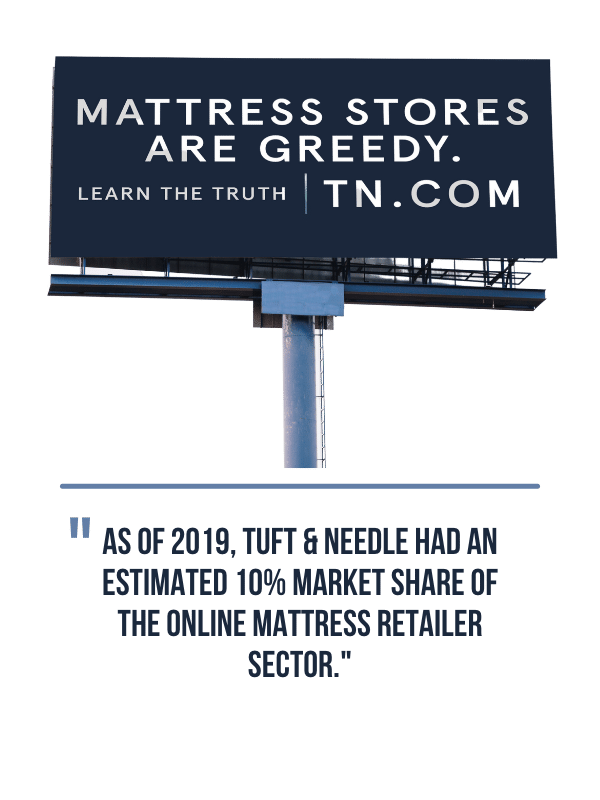
How Brands Can Learn from Mattress Companies
Traditionally, a mattress has never been the most exciting product. Despite the average person reportedly spending around 33 years of their life in bed, a mattress just wasn’t a long-term purchase many people paid attention to.
Until recently, a mattress purchase was a disjointed process that was more of a chore than anything. Your first step would be to visit one or more mattress stores (or mattress departments of major department stores), where a salesperson would prompt you to lie on numerous mattresses until you picked the least-worst one on sale.
Getting the mattress delivered was another ominous event of its own. There’s a reason why Google displays 5.6 million search results for the query “how to get a mattress upstairs.”
Yet, regardless of this tedious and sometimes painful process, the domestic mattress market in the U.S. continued to grow steadily, with the ISPA (International Sleep Products Association) showing wholesale sales growing from $1.4 billion in 1981 to $8.0 billion in 2016, and retail sales following a similar trajectory.
Despite this, the market was dominated by “old-fashioned” mattress brands that required large showrooms and a sales team to function. The mattress industry was ready for reinvention and reimagination to appeal to Generation Y’s new spending power.
ARTICLE BY:
Graphics: Carolina Molina
CONTACT US:
PUBLISHED ON:
January 30, 2021
The Market Changes
The interest in sleep and sleep technology has increased significantly in the last decade. Wearable technology can tell us the quality of sleep we get, and we generally care about sleep a lot more. A 2018 study revealed that Americans were starting to sleep longer, and developing healthier sleeping habits.
Google reinforces this growing interest in sleep by showing a steady rise in search queries for the sleep topic, especially between 2010 and 2020.
The search for the mattress topic shows a more pronounced increase in popularity, with interest more than doubling between 2014 and 2020.
Euromonitor data backs up Google’s insights, reporting that the U.S. mattress industry grew 20% between 2013 and 2018, to $17.8 billion. It also shows an estimated growth of 9.3% between 2018 and 2023, to $18.9 billion.

What Happened Between 2013 and 2018 That Triggered This Sharp Growth?
Predominantly in 2014 and 2015, several newly formed companies that spotted the need and potential for change within the retail mattress industry transformed the mattress market by offering a direct-to-consumer (DTC) service, taking advantage of memory foam’s pliability to sell a bed-in-a-box experience.
This bed-in-a-box product targets the traditional pain points of buying a mattress. No need to visit a store to try out mattresses, no more back-breaking mattress moving, and a cheaper product price thanks to the lack of showrooms and sales staff.
A new generation of mattress suppliers overtook the likes of Mattress Firm, Sleep Number, and American Mattress, and investors flocked to back these new mattress startups. CBInsights calculated that 13 leading mattress companies received their first funding between January 2014 and October 2016, with much of that funding happening in 2015.
These newly formed companies were the driving force behind a shift in the perception of the mattress. No longer was the process of buying a mattress an arduous experience. Now, a mattress could be purchased online from a cool, attractive brand, and delivered to your door in a handy box that’s perfect for a YouTube unboxing video.
What makes these new brands so attractive to consumers and investors alike? Here, I analyze three prominent mattress companies to see what common traits they share.
Purple
One of the most successful of the new breed of mattress brands is Purple, a plucky startup that went from a Kickstarter campaign to a NASDAQ company within three years.
The brand name is a far cry from the limiting “Mattress Firm” or “American Mattress.” Instead, it deploys the power of a familiar color described as emoting feelings of creativity, innovation, and luxury. Those are certainly sensations that the founders of Purple would like the brand to be associated with.
Purple has successfully identified the pain points of the traditional mattress-buying experience and has addressed each one.
Initially, Purple addressed the pain points in the form of viral ads. “The Raw Egg Test,” for example, has received more than 188 million YouTube views to date. Purple’s VP of Brand, Burke Morley, said in a 2019 interview that Purple’s ads in total had received over 1.5 billion views.
By extrapolating data from SimilarWeb stats for Purple, we can estimate that YouTube traffic accounts for 35,000 visitors to Purple.com every month.
Purple’s overall marketing and branding strategy is as far removed from a traditional mattress company as is humanly possible. Purple’s ability to reinvent the mattress idea in consumers’ minds is one reason why the company reached a reported $265 million in sales in 2019 and achieved a 32% market share in the online mattress retail industry.
Intrinsic to Purple’s ability to operate is its website. The brand has invested significantly in its website, but did you know it has also invested heavily in its domain name?
Purple sells on Purple.com, with the company finally securing the domain in November 2017 for $900,000 as an upgrade from OnPurple.com. SimilarWeb estimates that Purple.com received 3.97 million visitors in December 2020.
Casper
Casper could be considered the first company that proved the concept of selling a bed-in-a-box online.
Launched in 2014, Casper sold $1 million worth of mattresses in the company’s first 28 days. That momentum propelled the likes of Leonardo DiCaprio, Ashton Kutcher, and 50 Cent to participate in funding rounds that only led to more buzz around the company.
This momentum was later intensified as Kylie Jenner featured Casper in an Instagram post that garnered 860,000 likes. Neil Parikh, a Casper co-founder, said, “Oh my God, when Kylie Jenner posted about Casper, I think it broke our website.”
Aside from social media influencers, Casper’s sales have been driven by its users in the form of YouTube unboxing videos.
This led Casper to an estimated 50% market share in 2017-2018 among online mattress retailers. Their market share fell to 37% in 2019, but nonetheless, Casper has a strong hold on the online mattress industry, reporting $439.3 million in revenue in 2019. The company also raised $100 million in 2019 at a $1.1 billion valuation, putting it in unicorn territory.
On the back of this momentum, Casper went public in 2020.
The choice of “Casper” as a brand name was somewhat serendipitous, as Casper was reportedly the name of an easygoing college friend of the founders. It’s also the name of the well-known “Friendly Ghost,” which likely didn’t hurt.
As with Purple, at the heart of Casper’s billion-dollar brand is its exact brand match domain name. Casper paid an undisclosed fee to acquire Casper.com just months after launching, upgrading from CasperSleep.com. The domain name still plays a pivotal role in how consumers interact with Casper, with SimilarWeb estimating that 2.66 million users visited Casper.com in December 2020.
Tuft & Needle
Tuft & Needle is one of the original bed-in-a-box brands. Founded in 2012, Tuft & Needle was a bootstrapped venture that the founders transformed into a company producing over $100 million in annual revenue. The company is one of a small minority that hasn’t disclosed any kind of funding to date.
Although Tuft & Needle isn’t as concise a brand name as Purple or Casper, it’s a name that fulfills the founders’ aims for “a name, and a company, that was authentic, craftsman-like, original, timeless and modern.”
While the brand was initially successful, reaching $1 million in sales by 2013, the company didn’t truly gain fame until 2016 when Tuft & Needle launched a national billboard campaign titled “Mattress Stores Are Greedy.”
The billboard campaign prompted readers to go to TN.com, a domain name the company wisely purchased in September 2015, to easily direct new users to its existing TuftAndNeedle.com website.
Tuft & Needle’s addition of TN.com to its arsenal helped to counteract readability issues with tuftandneedle.com on billboards and print media, and audibility problems on radio and TV.
As of 2019, Tuft & Needle had an estimated 10% share of the online mattress retail market. The mattress brand also reportedly sold $170 million worth of products in 2019.

Other Players
Despite the dominance of Casper, Purple, and Tuft & Needle, there are more than 175+ online mattress companies today, according to a CNBC article. Several of these other brands stand out, including:
Lull. Operating on Lull.com, this is another brand founded in 2015. The self-funded company uses a cathartic brand name that sells the idea of getting a better sleep.
Bear. Did you know that bears can sleep for more than 100 days during the winter?
Nectar. Nectar, the sugary fluid in flowers, is the energy source for an entire workforce of insects. Is it also the source of rejuvenation for humans? It seems so, as Nectar experienced 525% sales growth in 2018 and recorded $250 million in revenue.

The Road to Success
For Casper, Purple, and the other major players in the mattress industry to be successful, it has taken bringing the right product to market at the right time in combination with ingenious marketing strategies.
However, a hefty marketing budget cannot account for a poor brand name. The best sleep brands carefully chose names that have a long association with the core solution they are trying to sell — a product for better sleep.
The road to success starts with the company’s name. Get that right, and the road becomes ever so slightly smoother.
The Future for Mattress Brands
In Purple’s 2019 end-of-year SEC filing, the company noted that: “The barriers to entry into the retail bedding industry are relatively low. New or existing bedding retailers could enter our markets and increase the competition we face.”
In an industry filled with companies largely vying to appeal to the same consumers, it’s unsurprising that the competition is high. The strategy that Purple and other leading brands such as Casper employ to counteract the competition is to introduce added “Comfort Industry” products such as pillows, sheets, and duvets.
Thanks to the generic nature of the Purple and Casper brand names, along with their ownership of the Purple.com and Casper.com domain names, respectively, the companies can release additional product lines smoothly.
What Can We Learn?
The new breed of mattress companies embodies the perfect case study into successful branding and execution. While large mattress retailer Mattress Firm filed for Chapter 11 bankruptcy in 2018, the newbies profited. How have Purple, Casper, Lull, and the other brands excelled?
First, these companies offer a solution to the traditional pain points of buying a mattress. The clunky, archaic system has been replaced by a seamless buying experience from a plethora of cool new brands.
Second, these brands quickly created memorable viral marketing campaigns that drove buyers in the thousands to their respective websites. The marketing campaigns, though, couldn’t be effective without a strong brand name, which brings us to the third lesson.
The likes of Purple, Casper, and Lull redefined the typical mattress brand by using memorable, attractive, and emotive names to sell the idea of helping the consumer get a better night’s sleep.
The success of these brand names is tied with the acquisition of their exact brand match domain names — Purple.com, Casper.com, and Lull.com — to create powerful online destinations for direct-to-consumer sales.
This new breed of mattress firms knows how to brand. Can you say the same?

